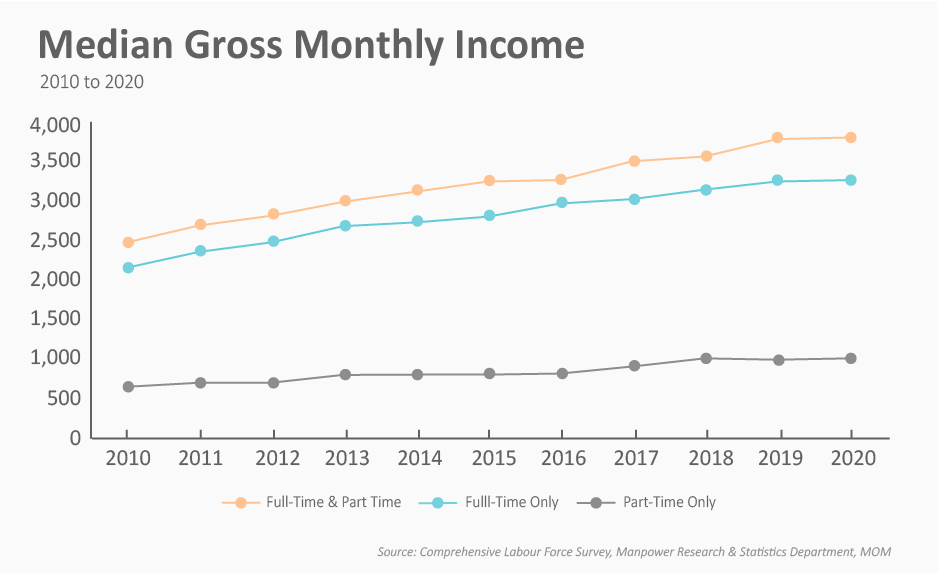Decades of social revolutions have led to the increasing recognition of women rights and equality in all aspects of our community, including job opportunities. As one of the most progressive nations in the world, Singapore has seen a steep increase in the labour force participation rate (LFPR) for women, as well as in their total full-time employment rate, median gross monthly income, and variety of flexible working arrangements (FWAs) available.
The rise in LFPR among women from 2010 to 2020 suggests that more women are joining the workforce and subscribing to more financially independent lifestyles. This is especially so over the last three years, as female labour force participation rate rose from 60.2% in 2018 to 61.2% in 2020.
There has also been a steady increase in full-timers over the last three years as women increasingly commit to their careers. Highlighted in orange, the proportion of full-time employment exhibited a rise over the decade, against the backdrop of a growing total female employment rate.
However, common issues that working women face include the widely debated gender pay-gap, the proportion of senior positions going to men, and societal expectations for them to adhere to traditional gender roles in more domestic responsibilities compared to men. The traditional role of women as the primary caregiver of the family might have created disadvantageous circumstances for them in the workplace, but we are progressively forging a path to gender inclusivity by implementing policies targeted at boosting working women.
The establishment of flexible working arrangements (FWA) encourages work-life balance so that all employees can better manage their work responsibilities. This is especially helpful for women, who often find themselves struggling between the fulfilment of career aspirations and family. In 2020, the proportion of firms which offered at least one formal FWA rose drastically to 78%, from 53.1% in 2018. Close to 6 in 10 firms also offered more than one formal FWA in 2020, thus providing employees, particularly women, a variety of schemes to choose from in order to effectively meet their needs. This way, they do not lose out on valuable work experience.
To encourage women to take on higher, managerial positions, the council for Board Diversity was also established in 2019 by Ministry of Social and Family Development with the aim of achieving a sustained increase in women on the boards of private companies and public organisations. Promising results have been observed as women's participation on the boards of the top 100 listed companies showed an increase from 15.2% in 2018 to 17.6% in 2020.
Additionally, more women are in PMET (Professionals, Managers, Executives, and Technicians) occupations, rising from 50% to 59% of employed females from 2010 to 2020. With women now better equipped to develop their careers and stepping into higher-paying industries, we have also observed a rise in the median gross monthly income for both full-timers and part-timers (including Employer CPF) over the decade.

Most notably, the discrepancy in Singapore's Adjusted Gender Pay Gap has narrowed from 8.8% in 2002 to 4.3% in 2020. A lower number is great news because this means that women are progressively catching up to their male counterparts and closing the gap in terms of wages, in tandem with evolving attitudes and the dissipation of gender discrimination in the workplace.
While much remains to be done to support our women in the workplace, the measures that have been implemented indicate a promising inclination to continue striving toward a progressive, gender-inclusive workforce, which has been rewarded with optimistic results.
For more information, you may access https://stats.mom.gov.sg/Pages/Update-on-Singapores-Adjusted-Gender-Pay-Gap.aspx.